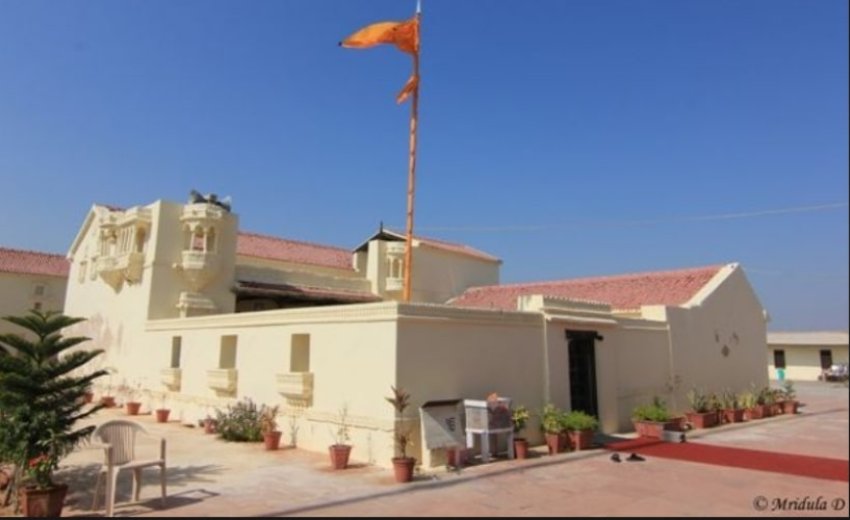In the state of Gujarat, there's proof of Guru Nanak Sahib Ji's visit. Sikhs had forgotten about this place and other places where Guru Nanak had been. But it's never too late. It's time to piece together our historical roots and explore our valuable heritage connected to the first Guru .
Historical Account
Guru Nanak Sahib went on two journeys, one from 1506 to 1513 and another from 1519 to 1521. During these trips, he travelled to Mecca. He also went to a place called Basta Bandher in the Sind province, which is now known as Lakhpat. Lakhpat is about 135 kilometres away from Bhuj, near Cori Creek on the border between India and Pakistan.
Lakhpat Fort is situated around 20 kilometres away from Korini village. In this area, there is a large Sarovar (sacred pool) built in memory of Guru Nanak Dev Ji's visit. Lakhpat got its name because the daily earnings from ship trade at its shores used to exceed one lakh cories, which was the local currency at that time.
Since 1947, Lakhpat Fort has been the home of the last outpost of the Border Security Force. About 400-500 people live inside its walls, and there are many temples and Sufi shrines. One notable place is Gurdwara Pehili Padshai "Lakhpat Gurdwara." There is also Hatkeshwar Temple, which has fossilized shells, as well as the Gosh Mohmmad Kuba, Darghah of Syed Pir Shah, and Nanai Mai Darghah –all stand witness to the glorious past.
Legend has it that Guru Nanak once visited a Brahman's house within the Lakhpat Fort. Local people say that this house was turned into a Gurdwara about two hundred years ago. The Gurdwara was given a large amount of land for its upkeep, maintenance, and regular expenses.
Nowadays, the Sindhu River no longer flows alongside the fort's banks because it was redirected during a major earthquake in Bhuj in 1819. It now flows to the west, into what is currently Pakistan's Sindh province. Even today, you can find countless shells in the ground from when the Sindhu River's bed dried up.
The restored gurudwara
The Gurdawara was restored to its present immaculate state by the strenuous efforts of the United Nations volunteer programme during seven months between February and September 2003. Thanks to their efforts, the assistance of the local community and the Sikh Sangat from Gandhidham, the Gurdwara has the unique distinction of being awarded the Asia Pacific Heritage Conservation award for the year 2004 by UNESCO. Carried out under the aegis of CRCI (Cultural Resources Conservation Initiative), it was a major conservation project.
Conferring the award UNESCO stated, "The restoration of this Sikh house of worship demonstrates a sophisticated holistic understanding of both the technical and social aspects of conservation; careful attention to detail and sensitive repair work have ensured the retention of the building's historic character. The emphasis on involving and empowering the community ensures the long-term survival of the historic building and its associated cultural traditions.” More than $ 43,000 grant was made by UNESCO to restore the holy place to its pristine glory, with conservation architects and masons brought in from Delhi, Punjab, Rajasthan, Madhya Pradesh and Gujarat to assist in restoration work.
A glimpse into the architecture of the Gurudwara
Let’s picture it. The Gurdwara complex includes a main building with a courtyard and a separate two-story gateway on the western side featuring massive wooden doors. Both the internal and external walls are adorned with paintings displaying floral patterns, including ships, flowers, and royal figures from that era.
The walls also bear religious writings in old Gurmukhi script left by past travellers. The Gurdwara is constructed from limestone and decorated with statues of elephants, flowers, Chabutras, and various human and animal figures embedded into the walls. The verandah features beautifully carved wooden columns. The entire area exudes a sense of history and a charming nostalgia.
The main room holds precious items connected to Guru Nanak Sahib. It's believed that Guru Sahib gifted these items to the Brahmin who hosted him. These items include wooden footwear called Charan paduka-khdawans (footwear) and a special Palki used by the Guru. They are displayed in a sealed glass case along with the holy Guru Granth Sahib. These are among the most sacred relics of Guru Nanak Sahib in India. In the nearby room, there are ancient handwritten Gurmukhi religious books and old scriptures, which are preserved behind wooden and glass panels.
*Based on an article written by Gurpreet Singh Anand, published in World Sikh News on 13th January 2010
